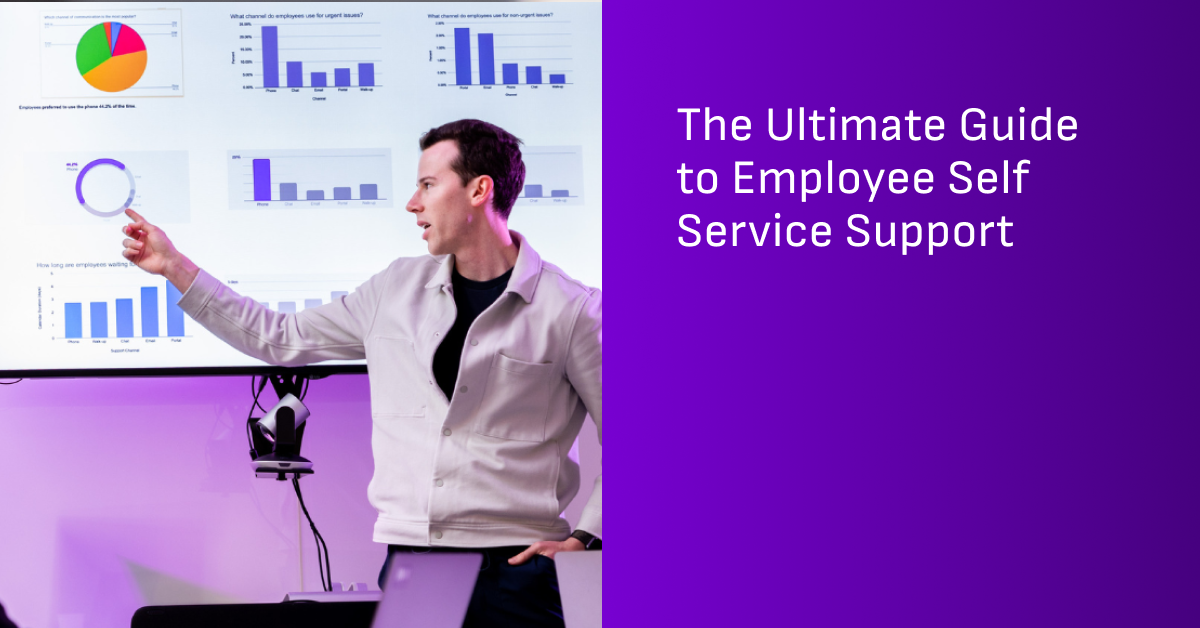Table of contents
Your employees are your company's greatest asset — but only when they have the support they need to do their jobs.
Too often, they waste valuable time hunting for information instead of focusing on meaningful work.
According to Gartner, 47% of employees struggle to find the information they need to do their work effectively. That’s a drain on productivity and a growing burden on IT and HR teams, who are usually stuck helping employees locate hard-to-find assets.
Instead of letting simple requests slow everyone down, employee self-support helps to give your team instant access to the help they need.
Now they can access instant support with fewer tickets, bottlenecks, or backlogs.
In this guide, we’ll break down how self-service tools work, their benefits, and how to set up a system that reduces busywork and increases efficiency for everyone.
What is employee self-service support?
Employee self-service support gives your team instant access to the answers and resources they need — without waiting on IT or HR.
Instead of submitting a ticket or sending an email, employees can use AI-powered self-service tools to troubleshoot issues, find company policies, and complete routine tasks independently.
Some self-service support tools use conversational AI to engage with employees in a human-like question-and-answer format. For example, employees can send a Slack message to an AI chatbot to request time off, get help resetting a password, or find an onboarding checklist.
These user-friendly, AI-powered assistants are often able to pull information from internal systems and knowledge bases, then aggregate and deliver quick and relevant responses.
Modern AI solutions go beyond simple FAQs or static, hard to update portals. They can handle complex issues, automate workflows, enhance your employees’ user experience, and free up customer support teams by resolving issues faster than traditional service desks.
Want to see how today’s IT teams are leveraging AI for self-service? Download your free resource guide.
6 ways self-service support tools benefit enterprise businesses
Self-service solutions aren’t just about convenience — they’re a potential game-changer for efficiency, cost savings, and employee satisfaction.
Here are six key ways self-service support can benefit your enterprise:
1. Minimize support staff busywork
Your HR and IT teams handle critical business functions — onboarding new users, creating training tutorials, optimizing workflows, and managing security. But when they’re constantly fielding employee questions, it pulls them away from higher-impact initiatives.
With AI-powered tools, employees can quickly find answers in self-service resources like knowledge base articles instead of submitting tickets or waiting on human agents for support.
AI chatbots integrated with internal systems allow employees to troubleshoot issues, retrieve documents, and complete simple tasks independently — freeing up IT and HR teams to focus on business operations and strategic initiatives.
Take Equinix, for example. Supporting a global workforce while maximizing IT efficiency was a challenge. By implementing an AI-driven support tool, Equinix achieved 96% ticket routing accuracy, helping to reduce the burden on support agents.
As a result, teams spend less time on ticket assignments and more time focused on high-priority tasks.
2. Reduce resolution times
As your business grows, so do support demands. This often leads to more help desk requests, creating ticket backlogs, longer resolution times, and frustrated employees.
Self-service channels give your employees direct access to the resources they need, minimizing their reliance on human support team members.
Instead of submitting tickets and waiting for assistance, they can reset passwords, update software settings, or follow step-by-step instructions to request access permissions — instantly.
AI-powered automation helps eliminate common bottlenecks, allowing IT teams to focus on more complex technical challenges.
3. Future-proofing and cost savings
Scaling your business requires strategic planning — not just for new systems and services but also for the time and resources needed to support them.
While it might seem like hiring additional support staff is the obvious solution, growing your team isn’t always efficient. In many cases, it drives up operating costs without delivering proportional value.
Some organizations turn to managed service providers (MSPs) as a more affordable alternative, but variable pricing structures can make long-term costs unpredictable.
Self-service solutions offer a scalable, cost-effective way to support your business as it grows. By automating routine tasks and minimizing the need for additional hires, businesses can optimize resources, reduce support costs, and maintain efficiency — ensuring long-term sustainability without unnecessary overhead.
4. Centralize the knowledge base
Providing employees with business resources is essential, but accessibility determines how well they can use them.
A self-service portal with a centralized knowledge base can house items like:
- How-to guides
- Troubleshooting tips
- Frequently asked questions
- Policy documents
- Video tutorials
- System access forms
This setup makes it easy for employees to find answers without jumping between multiple systems.
Broadcom, a global infrastructure technology company with 15,000 global employees, saw the impact of centralizing information firsthand. Using an advanced conversational AI platform, they could automatically address 57% of IT issues.
5. Enhance employee efficiency
Your employees will likely experience delays from time to time. Small but frequent challenges like resetting passwords, locating documents, or accessing customer data eventually add up.
But these delays impact more than one person.
Let’s say one of your sales reps needs customer data before a follow-up call. If they submit a request and wait for your support team to manually pull the report, both sides are wasting time.
AI-driven self-service tools eliminate these bottlenecks by giving your team instant, on-demand access to information. Whether gathering insights, troubleshooting software, or answering HR questions, these tools solve your employees' problems without disrupting their workflow.
Albemarle, a global chemical company, saw a huge increase in efficiency when they started using an AI platform to help resolve 80% of their support tickets — and reducing back-and-forth communication between employees and their IT department.
6. Boost employee satisfaction
When your employees have easy access to the resources they need, they're empowered to solve more problems on their own. A reliable self-service support solution can help them gain more confidence, boosting morale and even job satisfaction.
Procore, a construction management software company, wanted to improve support for its younger, digital-native workforce. By launching an AI-powered chatbot, they provided best-in-class support without increasing their IT headcount.
The result? 98% of employees are satisfied with their experience.
What support tasks can be automated?
Want to automate your self-serve service desk offerings but not sure where to start? AI-powered self-service tools go beyond simple support. You can use them to reduce manual workloads for IT and HR teams, improve productivity, and streamline common tasks, including:
Password and multi-factor authentication resets
Access issues can stall your employees’ productivity, and manually handling password and multi-factor authentication (MFA) resets is a drain on your IT department.
With AI-powered self-service automation, your employees are able to securely reset passwords and MFA credentials on their own. AI tools have the power to automatically recognize their requests, apply verification protocols to confirm their identities, and restore access instantly (even outside of business hours).
Remind and enroll employees in training courses
Ongoing skill development is essential for your employees’ career growth and business success. But managing training enrollment manually can be tricky.
AI-driven systems can also send timely reminders about upcoming training sessions. This keeps your employees on track and gives your management teams an efficient way to track certifications, compliance requirements, and progress — without manual follow-up.
To learn more about how agentic AI can benefit your business, download our free guide, which explores 100+ different self-service use cases.
Maintain up-to-date employee records
Keeping payroll, benefits, and personal details up to date can require a lot of back-and-forth between your employees and the HR team. But with a self-serve record-keeping system, individuals can update their own information — saving time and reducing administrative burden.
This simplifies processes like open enrollment updates and contact detail changes — plus, fewer manual touchpoints help reduce human errors. (No one wants to mess with payroll!)
Find the most recent assets and resources
Because of agentic AI's ability to understand context and natural language, it’s an ideal candidate for tasks that require some reasoning.
“Show me the latest Q2 sales report.”
Advanced agentic AI assistants can understand your intent: Even though you may ask the same question every year, assistants can understand context and will show you the relevant report.
Submit, review, and take action on time-off requests
Your HR teams can set up preconfigured policies, approval workflows, and real-time notifications in their systems. Your employees can also submit their time-off requests through a chatbot or portal and receive instant confirmation.
Automating this process with self-service support tools helps put a stop to the unnecessary back-and-forth and can speed up approvals.
Review and approve (or reject) expense reports
If you don't have an efficient review and approval system, processing reimbursements can be slow and tedious.
AI-powered self-service tools help you simplify this by automatically extracting data from submitted receipts and expense reports, categorizing expenses, and cross-referencing them with company policies, pre-approved spending limits, and approval hierarchies.
This lets your accounting teams quickly review and approve reimbursements — eliminating manual processing while maintaining compliance.
Schedule meetings
Coordinating meetings across your teams can be a hassle. Scheduling conflicts, miscommunications, and endless emails often create unnecessary confusion and disruptions.
A self-service tool allows you to automate scheduling by integrating with team calendar apps like Google Calendar or Outlook. These tools scan availability, suggest optimal meeting times, and send invites on your behalf — streamlining scheduling and reducing conflicts.
Offer multi-lingual support
Having a diverse workforce or global customer base means you need accessible communication. But language barriers can make it difficult for your employees and customers to access company resources, learn about products, or find support.
Self-service tools with built-in AI translation allow your users to navigate FAQ pages, interact with chatbots, and access company resources in their preferred language. This improves accessibility, enhances user experiences, and shows your company's commitment to improving inclusivity.
Book a meeting room
If you have a larger office, finding an available meeting room can be a challenge. Without a clear system, your employees can often waste time searching for open spaces or dealing with double bookings.
AI booking systems simplify this by integrating with office calendar applications.
Your employees can ask an AI chatbot to find available rooms, specify attendees, and confirm bookings instantly. The system automatically scans their schedules, suggests the best options, and finalizes the reservation.
Project management access
If you’ve ever joined a new team and spent your first several days discovering you can’t access a bunch of tools, documents, or systems that you need, you’re not alone. It’s a common — but frustrating (and avoidable) — way of life at many companies, but it doesn’t have to be.
AI tools can automate project management access permissions, instantly connecting new team members to the documents and platforms they need. Advanced AI assistants like Moveworks can integrate with your existing systems to automatically assign permissions based on project roles and assignments.
How to implement employee self-service support
Ready to roll out self-service support in your company? Here’s how to get started:
Define the purpose and scope
Before taking on a project like this, think about exactly what you need to accomplish.
What do your employees need most? What common issues do they face, and how can automation help? Focus on:
- The most time-consuming tasks for each department
- Common questions your employees ask
- Workflows that would benefit from automation
Collaborate with IT, HR, and other relevant department leaders to determine what problems your self-service solution needs to solve — and any specific requirements it needs to meet.
This helps ensure that the system you implement aligns with your teams’ needs and overall business goals.
Deploy and monitor
Once you figure out what your self-service solution should address, you’re ready to roll it out. But for the best results, there are a few steps you need to take first:
- Verify system compatibility: Ensure seamless integration with your existing HR and IT systems, which may require API connections or third-party integrations.
- Validate and clean data sources: The quality of your data input can directly impact your output. As they say, “Garbage in, garbage out.”
After deployment, monitoring your system performance is key to long-term success. Consider tracking key performance indicators (KPIs), like:
- Employee adoption rates
- Customer support ticket resolution times
- Ticket escalations
- Operating cost savings
Grow user adoption
While offering self-service support options for employees is a great start, remember that it’s not just about the technology — you also have to get your employees to adopt it too.
Consider how to clearly communicate the new solution’s benefits and highlight how it can improve their daily workflows:
- Quick access to documents like pay stubs, tax forms, and company handbooks
- Faster time-off requests and benefits enrollment
- Reduced response times for support requests
- Greater visibility into career development opportunities
Keep the lines of communication open, too. Encourage feedback to help identify pain points and opportunities for improvement — and to ensure a positive experience for your employees.
Supercharge employee productivity with self-service support
As your business scales, keeping up with growing workloads, support ticket backlogs, and information silos can quickly become a challenge. Without the right tools, these issues can impact your productivity.
Advanced agentic systems like Moveworks AI Assistant offer a smarter way to manage your business’s growth with self-service support and give your employees a single source of truth.
By leveraging agentic AI technology, you can help automate IT issue response, provide real-time answers to employee questions, and deliver a unified support experience across your departments.
Ready to empower your workforce? Schedule a personalized demo of Moveworks today.



